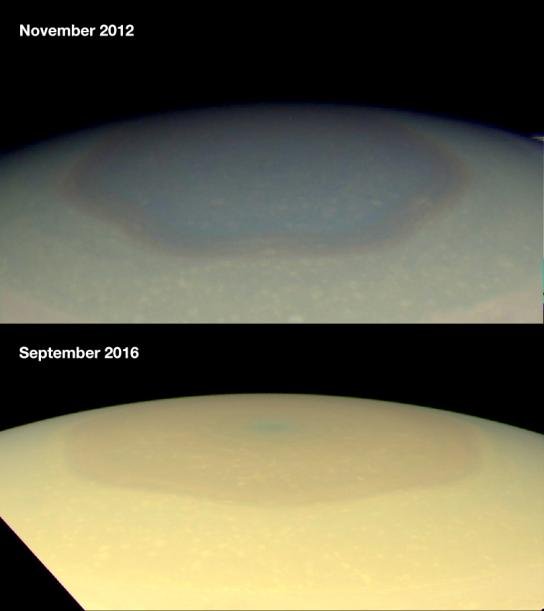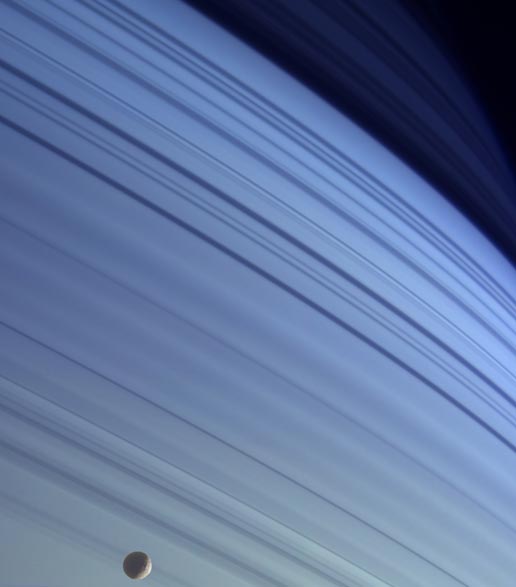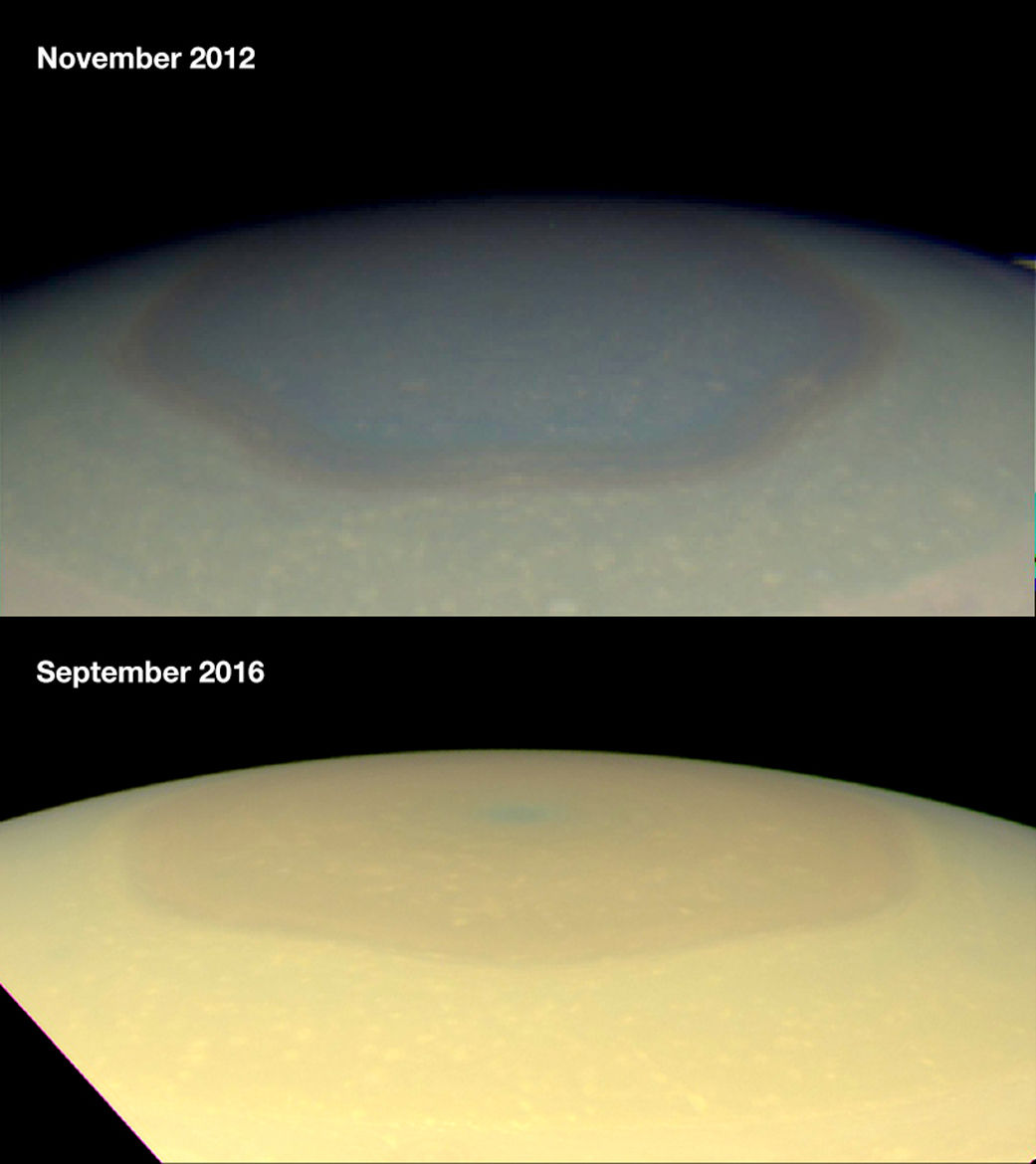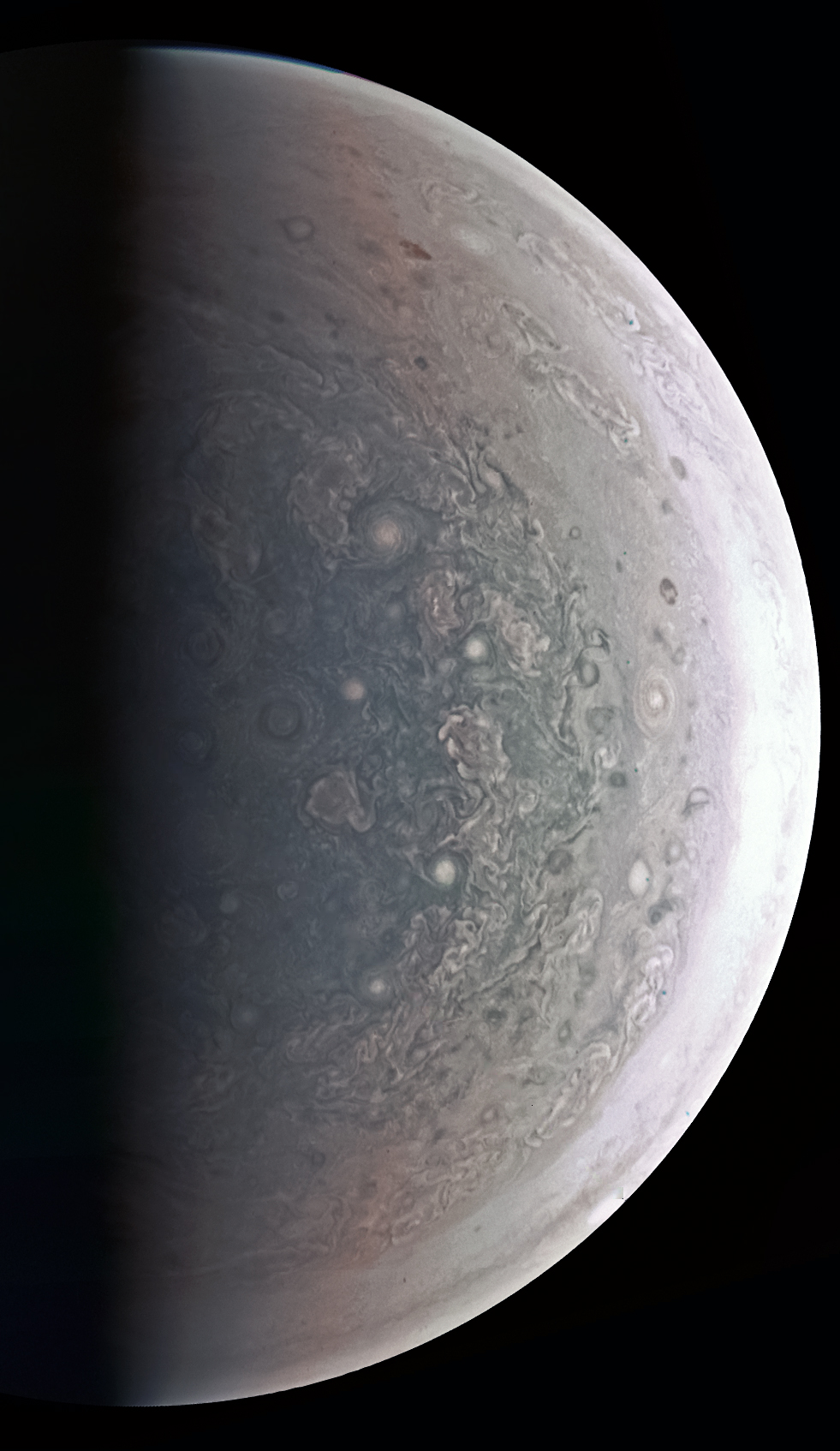It looks like you're using an Ad Blocker.
Please white-list or disable AboveTopSecret.com in your ad-blocking tool.
Thank you.
Some features of ATS will be disabled while you continue to use an ad-blocker.
share:
Based on images beamed back from Cassini, the hexagonal pole was blue back in 2012; since then it’s progressed into bright gold. Based on the images, which were released by the Cassini Imaging Team last week, scientists theorize that accumulating haze particles could be sparking this startling change. While it may seem bizarre for a vast swath of a planet to change colors so rapidly, there was a time between 1995 and 2009 when Saturn’s north pole grew increasingly dark. This, scientists deduced, was a result of diminishing photochemical reactions (i.e., less sunlight reached the planet to react with the atmosphere’s molecular components).

As if the hexagonal storm (technically a six-sided jet stream) circling Saturn's North Pole wasn't fascinating enough it goes and changed colour on us. First discovered in 1988 by NASA scientists analyzing data from Voyager's 1980 & '81 flybys. In November 2012 the gas giant's North Pole was blue/black in colour but since then it started changind tone until it was Gold in Spetember of this year. It is thought that this is a photochemical reaction linked to the planet's seasons but the jury is still out on the exact cause.
I've always found things like this fascinating, i was 11 or 12 when we first saw Saturn's Hexagon, by that time I already had a healthy interest in all things space, this really egged that on.
Here's the link for the article I discovered.
edit on 1/11/16 by
djz3ro because: because i forgot pics and links...
The Reptilians are Terra-forming it as a base for their pending invasion!
Seriously though, that's pretty cool. Space is awesome and we don't even have to look past our own solar system.
Thanks for sharing
Seriously though, that's pretty cool. Space is awesome and we don't even have to look past our own solar system.
Thanks for sharing
originally posted by: watchitburn
The Reptilians are Terra-forming it as a base for their pending invasion!
Seriously though, that's pretty cool. Space is awesome and we don't even have to look past our own solar system.
Thanks for sharing
Agreed, it would be amazing to be alive in a time where we can traverse the cosmos
a reply to: watchitburn
No claims to truth or accuracy, but here it goes: the world known as Agartha or Asgard is located where Saturn is but is out of phase from our universe by virtue of technology to mask its presence. At the moment the hidden world is moving closer to revealing itself within the bounds of our universe. This is part of the End of Days or the Consummation of the Age. It is a good thing for some, but for most it is a very bad thing.
Enjoy!
No claims to truth or accuracy, but here it goes: the world known as Agartha or Asgard is located where Saturn is but is out of phase from our universe by virtue of technology to mask its presence. At the moment the hidden world is moving closer to revealing itself within the bounds of our universe. This is part of the End of Days or the Consummation of the Age. It is a good thing for some, but for most it is a very bad thing.
Enjoy!
a reply to: djz3ro
I remember something I read awhile ago. The Bermuda Triangle and many disappearing vehicles could be something have to do with strong hexagonal streams and clouds with windspeed way above two hundred miles or so trapping or destroying everything in its path.
Now what's the correlation between the Bermuda and Saturn beats me, but if the story about a crystal pyramid in the center of the Bermuda one day fits this story than it would make my theory, like just a theory that it also might be possible on Saturn ..
I remember something I read awhile ago. The Bermuda Triangle and many disappearing vehicles could be something have to do with strong hexagonal streams and clouds with windspeed way above two hundred miles or so trapping or destroying everything in its path.
Now what's the correlation between the Bermuda and Saturn beats me, but if the story about a crystal pyramid in the center of the Bermuda one day fits this story than it would make my theory, like just a theory that it also might be possible on Saturn ..
The blue colour of Saturn's hexagon comes from the scattering of sunlight in Saturn's atmosphere of hydrogen (similar to our blue atmosphere of
nitrogen and oxygen), whereas the yellowish colouration over the rest of Saturn comes from complex chemicals like hydrocarbons and ammonia, formed
under the effect of solar radiation.
As this NASA article from 2005 explained,
www.nasa.gov...

I guess that since 2005 there was a more active formation of those yellow clouds, and thus even the hexagon got affected.
As this NASA article from 2005 explained,
Saturn's northern hemisphere is presently relatively cloud-free, and rays of sunlight take a long path through the atmosphere. This results in sunlight being scattered at shorter (bluer) wavelengths, thus giving the northernmost latitudes their bluish appearance at visible wavelengths.
www.nasa.gov...

I guess that since 2005 there was a more active formation of those yellow clouds, and thus even the hexagon got affected.
originally posted by: wildespace
The blue colour of Saturn's hexagon comes from the scattering of sunlight in Saturn's atmosphere of hydrogen (similar to our blue atmosphere of nitrogen and oxygen), whereas the yellowish colouration over the rest of Saturn comes from complex chemicals like hydrocarbons and ammonia, formed under the effect of solar radiation.
Thank you, I published this thread last night when I waa tired, my intention was to get up this morning and look onto this to try and find the why of it all.
new topics
-
Little Johnny and Larry should team up
General Chit Chat: 1 hours ago -
Will Us use alien technology to fight in ww3?
World War Three: 1 hours ago -
posted in wrong forum
Aliens and UFOs: 1 hours ago -
Shane Gillis commercial
Jokes, Puns, & Pranks: 7 hours ago -
Elon Says It’s ‘Likely’ He Buys Tanking MSNBC
Political Ideology: 10 hours ago -
Montelukast affects brain, caused 5 year old to attempt suicide
Medical Issues & Conspiracies: 11 hours ago
top topics
-
Biden's "Reckless" Decision To Escalate Russia-Ukraine War
World War Three: 17 hours ago, 17 flags -
Elon Says It’s ‘Likely’ He Buys Tanking MSNBC
Political Ideology: 10 hours ago, 16 flags -
Montelukast affects brain, caused 5 year old to attempt suicide
Medical Issues & Conspiracies: 11 hours ago, 15 flags -
Jaguar Rebrand Video Causes "WTF?" Moment - Seriously Weird
Automotive Discussion: 13 hours ago, 14 flags -
What Joe Rogan said Vs The View
Dissecting Disinformation: 16 hours ago, 13 flags -
Shane Gillis commercial
Jokes, Puns, & Pranks: 7 hours ago, 4 flags -
Let's start a conspiracy
General Conspiracies: 13 hours ago, 1 flags -
posted in wrong forum
Aliens and UFOs: 1 hours ago, 0 flags -
Will Us use alien technology to fight in ww3?
World War Three: 1 hours ago, 0 flags -
Little Johnny and Larry should team up
General Chit Chat: 1 hours ago, 0 flags
active topics
-
Jaguar Rebrand Video Causes "WTF?" Moment - Seriously Weird
Automotive Discussion • 17 • : angelchemuel -
What Joe Rogan said Vs The View
Dissecting Disinformation • 22 • : TheMisguidedAngel -
Will Us use alien technology to fight in ww3?
World War Three • 1 • : atsalex2 -
Little Johnny and Larry should team up
General Chit Chat • 0 • : 727Sky -
Elon Says It’s ‘Likely’ He Buys Tanking MSNBC
Political Ideology • 72 • : nugget1 -
posted in wrong forum
Aliens and UFOs • 0 • : wrayth -
Montelukast affects brain, caused 5 year old to attempt suicide
Medical Issues & Conspiracies • 9 • : Daughter2v2 -
Well we know Putins ICBMs won't fail in their silos
World War Three • 174 • : 777Vader -
President-Elect DONALD TRUMP's 2nd-Term Administration Takes Shape.
Political Ideology • 234 • : WeMustCare -
-@TH3WH17ERABB17- -Q- ---TIME TO SHOW THE WORLD--- -Part- --44--
Dissecting Disinformation • 3352 • : Crazierfox


